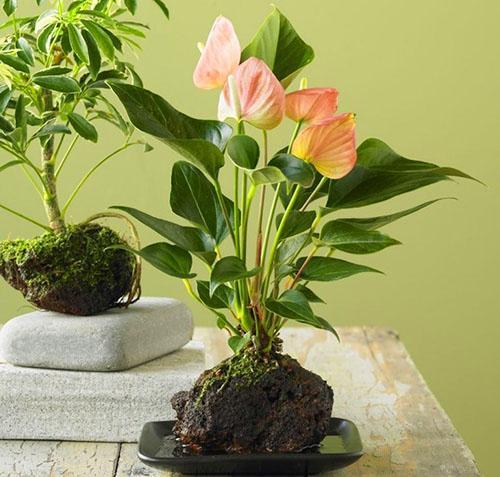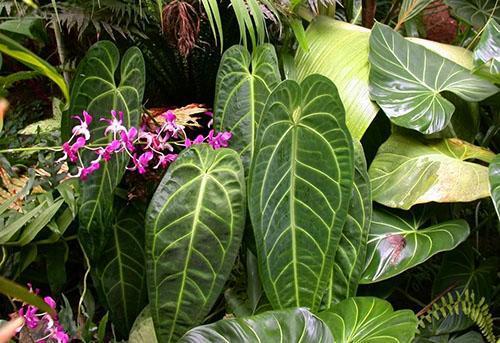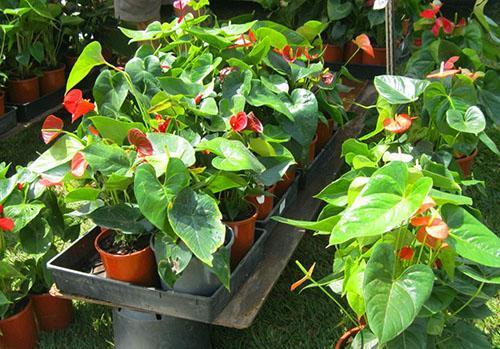Anthurium indoor plant care at home
 Anthuriums, brought to Europe in the 19th century, attracted close attention of indoor florists only at the end of the last century. Today, almost 30 species and 80 hybrid varieties of anthurium are at the disposal of everyone who is not indifferent to the representatives of the tropical flora.
Anthuriums, brought to Europe in the 19th century, attracted close attention of indoor florists only at the end of the last century. Today, almost 30 species and 80 hybrid varieties of anthurium are at the disposal of everyone who is not indifferent to the representatives of the tropical flora.
Among the plants grown in indoor conditions, there are not only flowering crops, but also interesting vines, as well as decorative deciduous species that attract attention not by inflorescences, but by variegated expressive foliage.
Moreover, all these dissimilar species are anthuriums that require the creation of a comfortable atmosphere and regular care. Since the growing conditions for people from the tropics of South America are quite close, indoor care for anthuriums has many common features.
Temperature conditions for growing anthurium

Anthurium does not like sudden temperature changes, drafts and cold winds.
When caring for anthurium at home, you can reduce the risk of root rot in a plant on a cold windowsill. To do this, you can raise the pot, or make a layer of foam insulation under it.
Lighting as part of the care of indoor anthurium
 Anthuriums growing in the shade of larger plants tolerate shade easily, and in bright sun they can seriously suffer. The best place for both brightly blooming and deciduous forms is the east and west windows. If this is not possible, you can create the proper conditions for growing anthurium on the south window by shading the pot or moving it away from the glass deeper into the room.
Anthuriums growing in the shade of larger plants tolerate shade easily, and in bright sun they can seriously suffer. The best place for both brightly blooming and deciduous forms is the east and west windows. If this is not possible, you can create the proper conditions for growing anthurium on the south window by shading the pot or moving it away from the glass deeper into the room.
On warm summer days, anthuriums are useful to take out into the air, providing plants with protection from strong winds, direct sunlight and precipitation.
The poor health of the plant due to excess sun is signaled by brown drying burns on the leaf plates and the rapid drying of the soil surface.
But the lack of light is indicated by the yellowing of the foliage, its pallor and excessive elongation of the cuttings. This happens on the north side and also in winter. Organization additional illumination not only helps to establish the care of indoor anthurium, but also stimulates its flowering.
Watering anthurium at home
 Novice gardeners sometimes have the misconception that tropical plants require abundant and frequent watering. And as a result of such improper care, anthuriums at home suffer from excessive soil moisture. In fact, when watering plants of the Aroid family, it is important to know when to stop.
Novice gardeners sometimes have the misconception that tropical plants require abundant and frequent watering. And as a result of such improper care, anthuriums at home suffer from excessive soil moisture. In fact, when watering plants of the Aroid family, it is important to know when to stop.
Both excessive watering and the content of green pets in a dry substrate are harmful.
At the same time, waterlogging of the soil is more dangerous, since it can cause rotting of the root system and the development of late blight. Therefore, especially in the anthurium contained in a cool room, the moisture that has drained into the pallet must be removed.And between waterings, the topsoil should be almost dry.
 On hot summer days and in a heated room, if the flower is grown under artificial lighting, care for indoor anthurium should include more frequent watering and processing foliage with a damp sponge. Such a measure will not only improve the appearance of the plant, but also make it easier to breathe.
On hot summer days and in a heated room, if the flower is grown under artificial lighting, care for indoor anthurium should include more frequent watering and processing foliage with a damp sponge. Such a measure will not only improve the appearance of the plant, but also make it easier to breathe.
Plants react to excessive hardness of irrigation water, as well as to excessive watering, by the appearance of black or dark brown spots on the leaf plates.
As a result of such an error in care, anthurium develops worse at home, and the affected foliage can no longer fully fulfill its functions. You can soften moisture by adding a little citric acid. For irrigation, use warm settled or melt water.
Air humidity for anthurium
Much more than the moisture content of the soil, the high moisture content in the air is important for anthurium.
 To create the growing conditions necessary for the anthurium, it is necessary to take care of the atmospheric humidity at the level of 75–85%. To do this, you can use:
To create the growing conditions necessary for the anthurium, it is necessary to take care of the atmospheric humidity at the level of 75–85%. To do this, you can use:
- irrigation of the green part with warm water;
- household humidifiers;
- improvised means, including placing the plant pot in a tray filled with wet gravel.
To prevent the leaves from becoming stained and black in a cool room, it is important to keep them dry. The same applies to inflorescences, often suffering from improper indoor anthurium care. Do not allow water to enter the decorative foliage of anthuriums, which are not smooth, but matte textured leaves.
During the heating season, varieties and species of anthurium that are sensitive to air dryness can be transferred closer to water sources, for example, to decorative fountains in well-lit bathrooms.
Anthurium requirements for soil
 In order for, as in the photo, anthurium to bloom well, grow and bear fruit at home, it needs the lightest structured substrate with an acidity level of pH 5.5-6.0 units. Since the roots of many anthurium species are adapted to consume moisture and nutrients and air and small accumulations of humus on the trunks and roots of large trees, they will be uncomfortable in a dense, heavy soil mixture and they can rot.
In order for, as in the photo, anthurium to bloom well, grow and bear fruit at home, it needs the lightest structured substrate with an acidity level of pH 5.5-6.0 units. Since the roots of many anthurium species are adapted to consume moisture and nutrients and air and small accumulations of humus on the trunks and roots of large trees, they will be uncomfortable in a dense, heavy soil mixture and they can rot.
To make potting mix, you can use:
- riding peat, cleaned of foreign inclusions;
- leafy ground;
- sand;
- the bark of coniferous trees, pre-boiled and crushed.
Two parts of land and peat will require one part of sand and bark. Crushed charcoal can be added to the soil, which will not only have a positive effect on the structure of the mixture, but also serve to disinfect the soil. A good supplement for epiphytic anthuriums is sphagnum moss and perlite, which loosen up any ready-made potting mix from the store.
 The details of planting, watering and creating other conditions for the plant will be told by a video on how to care for anthurium at home. Having a basic understanding of the life of a tropical culture, and striving to regularly pay attention to the pet, you can admire the indoor anthurium for a long time with a minimum of diligence.
The details of planting, watering and creating other conditions for the plant will be told by a video on how to care for anthurium at home. Having a basic understanding of the life of a tropical culture, and striving to regularly pay attention to the pet, you can admire the indoor anthurium for a long time with a minimum of diligence.
The best containers for anthuriums that form powerful aerial roots are small plastic pots with an obligatory drainage hole. In a pot for planting a houseplant, it is very important to arrange a powerful drainage layer so that moisture does not remain in the lower part of the earthy coma, but is removed.
If for growing at home, anthurium is planted in a mixture for orchids, the plant will need more frequent feeding, or a little disinfected garden soil should be added to the soil.
When caring for indoor anthurium during intensive growth and flowering, it needs to be fed. The procedure is carried out twice a month, using ready-made products or alternating organic and mineral supplements. Plants that are sent to rest for the winter period are not fed at this time, and their watering is reduced.But with lengthening daylight hours to 12-14 hours, you can get a constant flowering of anthurium. In this case, the fertilizing and watering schedule is not changed in the winter months.
 Anthurium does not need frequent transplants. But when the roots completely occupy the entire volume of the pot, at home, as in the photo, the anthurium is transplanted into a large container. To do this, the anthurium is transferred into a new pot, and the gaps on the sides are filled with fresh substrate. The topsoil is also renewed.
Anthurium does not need frequent transplants. But when the roots completely occupy the entire volume of the pot, at home, as in the photo, the anthurium is transplanted into a large container. To do this, the anthurium is transferred into a new pot, and the gaps on the sides are filled with fresh substrate. The topsoil is also renewed.
Most often, a healthy plant, excluding young specimens, needs a transplant in 2-3 years.
It is a different matter if the anthurium shows signs of illness. It is important here not only to transfer the earthy lump, but to clean the remains of the soil:
- check the status of the root system;
- cut off damaged roots;
- process the sections with crushed coal.
When selecting pots, you should not give preference to too large containers. Otherwise, the anthurium, caught in a large earthen lump, will not bloom until the roots have mastered the "spaces" allocated to them.
In addition, moisture that is not absorbed by the roots remains in the soil and more often causes the appearance of mold, the development of fungi and soil pests.
 An excessively deep planting of the plant can also lead to rotting of the stem. In order for the pet to keep better in the ground, it can be arranged with supports, which are especially useful when creating growing conditions for an anthurium in the form of a liana. The place where the stem emerges from the ground, if the plant rises slightly above the ground, can be sprinkled or compacted with sphagnum. In this case, the moist moss provokes the development of additional roots.
An excessively deep planting of the plant can also lead to rotting of the stem. In order for the pet to keep better in the ground, it can be arranged with supports, which are especially useful when creating growing conditions for an anthurium in the form of a liana. The place where the stem emerges from the ground, if the plant rises slightly above the ground, can be sprinkled or compacted with sphagnum. In this case, the moist moss provokes the development of additional roots.
When caring for indoor anthurium, it is also important to remember that plant sap can cause irritation, therefore, it is better to carry out all manipulations with roots and leaves with gloves.